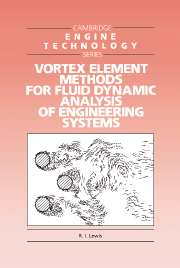Book contents
- Frontmatter
- Contents
- Preface
- Acknowledgements
- Part 1 The surface vorticity method for inviscid ideal fluid flow
- Chapter 1 The basis of surface singularity modelling
- Chapter 2 Lifting bodies, two-dimensional aerofoils and cascades
- Chapter 3 Mixed-flow and radial cascades
- Chapter 4 Bodies of revolution, ducts and annuli
- Chapter 5 Ducted propellers and fans
- Chapter 6 Three-dimensional and meridional flows in turbomachines
- Part 2 Free shear layers, vortex dynamics and vortex cloud analysis
- Appendix Computer Programs
- Bibliography
- Index
Chapter 4 - Bodies of revolution, ducts and annuli
Published online by Cambridge University Press: 05 November 2009
- Frontmatter
- Contents
- Preface
- Acknowledgements
- Part 1 The surface vorticity method for inviscid ideal fluid flow
- Chapter 1 The basis of surface singularity modelling
- Chapter 2 Lifting bodies, two-dimensional aerofoils and cascades
- Chapter 3 Mixed-flow and radial cascades
- Chapter 4 Bodies of revolution, ducts and annuli
- Chapter 5 Ducted propellers and fans
- Chapter 6 Three-dimensional and meridional flows in turbomachines
- Part 2 Free shear layers, vortex dynamics and vortex cloud analysis
- Appendix Computer Programs
- Bibliography
- Index
Summary
Introduction
Over the next three chapters we shall develop analyses to deal with progressively more complex problems in the fields of ducted propellers or fans and turbomachine meridional flows. As illustrated in Chapter 3, a design strategy frequently adopted for such devices involves representation of the fully three-dimensional flow as a series of superimposed and connected two-dimensional flows. These are of two main types, blade-to-blade and meridional flow. Having dealt with the first of these, we now turn our attention to the second principal turbomachine problem, calculation of the meridional flow. Turbomachine annuli, Fig. 4.1, are of many different configurations but are usually axisymmetric. For design purposes meridional through-flows are likewise often assumed to be axisymmetric. In general it is important to build into meridional analysis the interactions of the blade-to-blade flow which results in vortex shedding and stagnation pressure or enthalpy gradients. These matters will be dealt with in Chapters 5 and 6, including extension to a consideration of some three-dimensional flows which have been studied by surface vorticity modelling. In the present chapter the foundations will simply be laid for the analysis of axisymmetric potential flows by the surface vorticity method with applications to bodies of revolution, engine or ducted propeller cowls, wind tunnel contractions and turbomachinery annuli.
Axisymmetric flows are in fact two-dimensional in the mathematical sense, even in the presence of circumferentially uniform swirling velocities.
- Type
- Chapter
- Information
- Publisher: Cambridge University PressPrint publication year: 1991



